Trade Tariffs
Market and Economic Update – Week Ending 22nd June 2018

Peter Flannery CFP AFA
“If you have one economist on your team,
it’s likely that you have one more than you’ll need.”
Warren Buffett

- Donald Trump has threatened to apply tariffs on $200 billion of Chinese goods and follow up with sanctions on an additional $200 billion. So far the White House has confirmed tariffs on $50 billion of Chinese goods. The White House escalation took place after China reacted to the original announcement of $50 billion in tariffs with restrictions on a similar value of US goods.
- One response that China may no longer have is the devaluation of the currency – making the yuan cheaper. This tactic has been used at times in the past, however now China’s economy is quite a bit bigger so devaluing the currency would undermine significant efforts of the Chinese government in the past to stabilise the currency as well as possibly upsetting other countries apart from the US. It could even force China to buy more US treasuries.
- One tactic that China has used in the past with some success is to target specific areas within the economy for maximum effect. For example the Chinese initially targeted US goods produced by states in the US that played a significant role in Donald Trump’s upset victory in 2016. China has been cancelling orders for soy beans from Iowa and other mid-western farm states. The idea is to initiate a domestic backlash against Donald Trump and thereby force him to back down. Let’s see how that works … In addition, the Chinese government has been known to take both official and unofficial initiatives to encourage its own citizens and businesses to boycott foreign goods. China has experienced these types of tactics and has used them in the past to punish Korean and Japanese companies.
- So, China does have options however there appear to be limitations to what China can do. When you look at the numbers, we can see that last year, China shipped $505 billion worth of goods to the US but only imported $130 billion in American made products. So, the “tit for tat” response to tariffs is only going to go so far. Anyway, at this stage the damage to both economies has been limited but it could extend to some large American corporations such as for example Starbucks and Apple, who both have significant business interests in China.
Is the printing press slowing down!?
- The world’s two largest central banks (the US Fed and the European Central Bank) are both talking about reversing the so-called printing machine in the future. Whilst talk is cheap and we will need to wait and see what happens, interest rate rises in the US are an example of that reverse. Also some of the asset purchases carried out over the GFC have been scaled back as that reversal process continues in the US.
- The US Federal Reserve as you know has raised the range on the Fed funds rate to 1.7% to 2% recently and has indicated that another two rate hikes are likely this year. That’s a total of four for 2018. Recently the US Fed also upgraded not only the pace of future interest rate hikes but also its predictions for inflation, employment and economic growth. However some are questioning whether the intended fourth rate hike later this year in the US will actually eventuate given the dubious growth coming out of the rest of the world.
- The European Central Bank (ECB) have joined the US Fed in announcing the end of its asset purchase program in December. The ECB asset purchases have amounted to E€2.55 trillion. The Fed’s efforts amounted to USD$4 trillion. That is a significant amount of money but not that significant when you consider that global debt is over USD$200 trillion. Anyway the point of all this is that whilst some believe that the global economic system is about to blow up at any moment, I have trouble seeing that picture, any time soon. I suspect the resolution to global debt is a much more insidious scenario that ultimately infects everyday citizens of the world in a slow but painful way for a long time. For example, the buying power of the average wage in most countries is significantly less than what it was 25 years ago. Perhaps in overly simplistic terms, the rich get richer, the poor get poorer and the middle class continue to disappear. To be clear, whilst anything is possible, I am having trouble seeing an economic meltdown or global market armageddon like a number of internet jockeys continue to predict.

